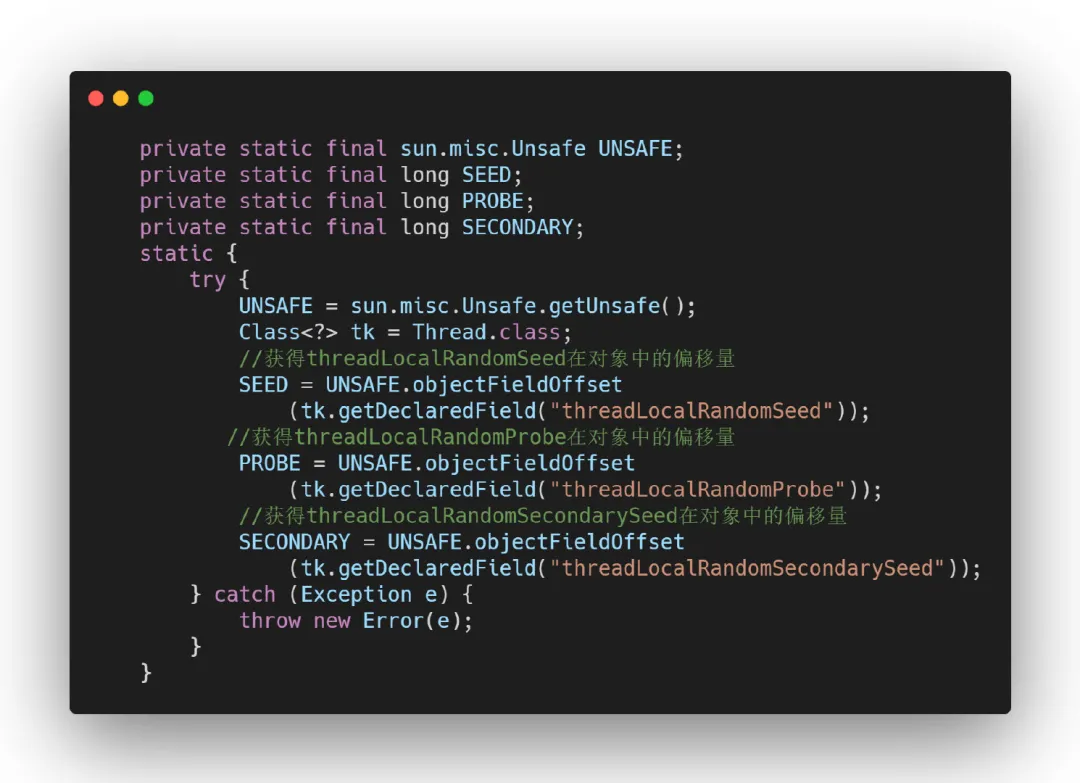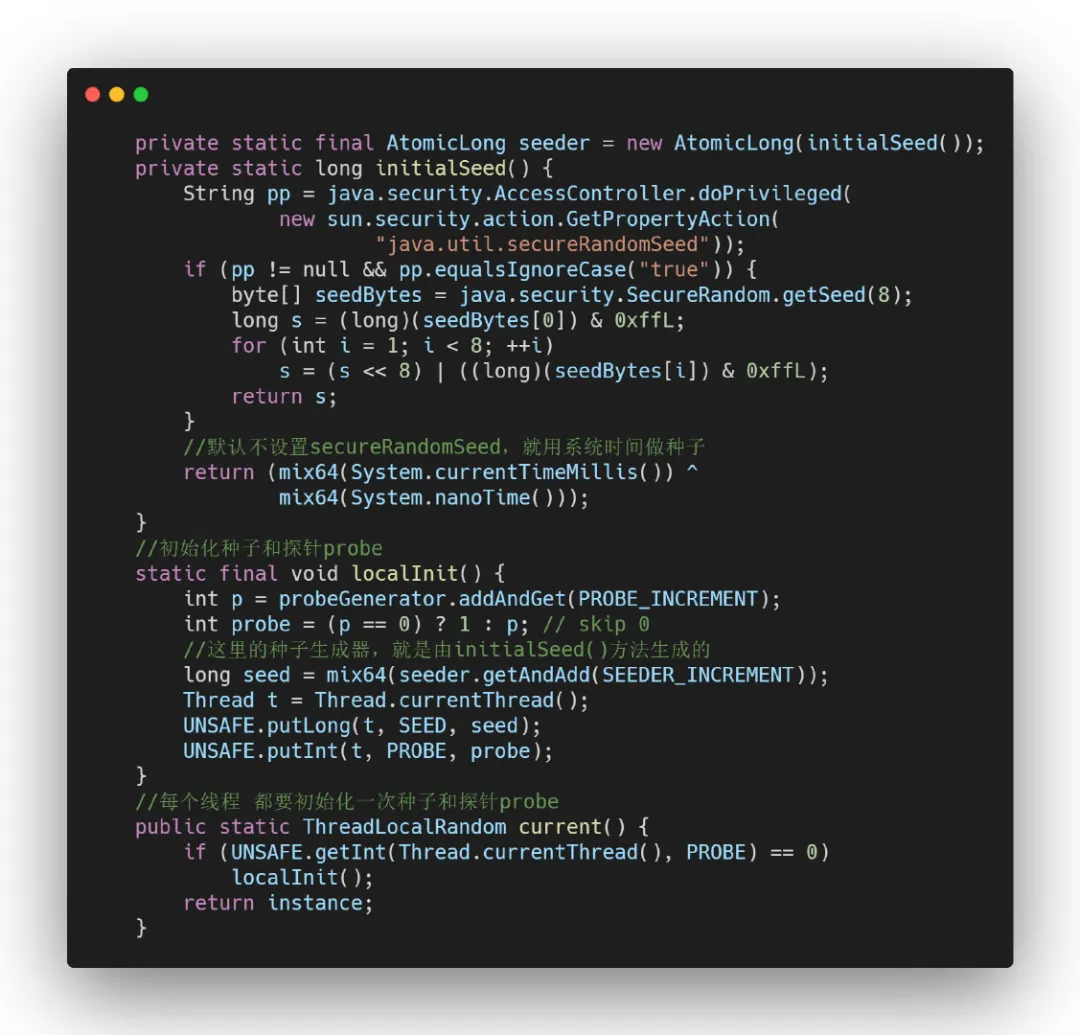前言
在代码中生成随机数,是一个非常常用的功能,并且JDK已经提供了一个现成的Random类来实现它,并且Random类是线程安全的。
下面是Random.next()生成一个随机整数的实现:
protected int next(int bits) {long oldseed, nextseed;AtomicLong seed = this.seed;do {oldseed = seed.get();nextseed = (oldseed * multiplier + addend) & mask;//CAS 有竞争是效率低下} while (!seed.compareAndSet(oldseed, nextseed));return (int)(nextseed >>> (48 - bits));}
不难看到,上面的方法中使用CAS操作更新seed,在大量线程竞争的场景下,这个CAS操作很可能失败,失败了就会重试,而这个重试又会消耗CPU运算,从而使得性能大大下降了。
因此,虽然Random是线程安全的,但是并不是“高并发”的。
为了改进这个问题,增强随机数生成器在高并发环境中的性能,于是乎,就有了ThreadLocalRandom——一个性能强悍的高并发随机数生成器。ThreadLocalRandom继承自Random,根据里氏代换原则,这说明ThreadLocalRandom提供了和Random相同的随机数生成功能,只是实现算法略有不同。
在Thread中的变量
为了应对线程竞争,Java中有一个ThreadLocal类,为每一个线程分配了一个独立的,互不相干的存储空间。ThreadLocal的实现依赖于Thread对象中的ThreadLocal.ThreadLocalMap threadLocals成员字段。
与之类似,为了让随机数生成器只访问本地线程数据,从而避免竞争,在Thread中,又增加了3个成员:
/** The current seed for a ThreadLocalRandom */@sun.misc.Contended("tlr")long threadLocalRandomSeed;/** Probe hash value; nonzero if threadLocalRandomSeed initialized */@sun.misc.Contended("tlr")int threadLocalRandomProbe;/** Secondary seed isolated from public ThreadLocalRandom sequence */@sun.misc.Contended("tlr")int threadLocalRandomSecondarySeed;
这3个字段作为Thread类的成员,便自然和每一个Thread对象牢牢得捆绑在一起,因此成为了名副其实的ThreadLocal变量,而依赖这几个变量实现的随机数生成器,也就成为了ThreadLocalRandom。
消除伪共享
在这些变量上面,都带有一个注解@sun.misc.Contended,这个注解是干什么用的呢?要了解这个,大家得先知道一下并发编程中的一个重要问题——伪共享:
CPU是不直接访问内存的,数据都是从高速缓存中加载到寄存器的,高速缓存又有L1,L2,L3等层级。在这里,先简化这些负责的层级关系,假设只有一级缓存和一个主内存。
CPU读取和更新缓存的时候,是以行为单位进行的,也叫一个cache line,一行一般64字节,也就是8个long的长度。
因此,问题就来了,一个缓存行可以放多个变量,如果多个线程同时访问的不同的变量,而这些不同的变量又恰好位于同一个缓存行,那会发生什么呢?
如上图所示,X,Y为相邻2个变量,位于同一个缓存行,两个CPU core1 core2都加载了他们,core1更新X,同时,core2更新Y,由于数据的读取和更新是以缓存行为单位的,这就意味着当这2件事同时发生时,就产生了竞争,导致core1和core2有可能需要重新刷新自己的数据(缓存行被对方更新了),这就导致系统的性能大大折扣,这就是伪共享问题。
那怎么改进呢?如下图:
上图中,把X单独占用一个缓存行,Y单独占用一个缓存行,这样各自更新和读取,都不会有任何影响了。
而上述代码中的@sun.misc.Contended("tlr")就会在虚拟机层面,在变量的前后生成一些padding,使得被标注的变量位于同一个缓存行,不与其它变量冲突。
在Thread对象中,成员变量threadLocalRandomSeed,threadLocalRandomProbe,threadLocalRandomSecondarySeed被标记为同一个组tlr,使得这3个变量放置于一个单独的缓存行,而不与其它变量发生冲突,从而提高在并发环境中的访问速度。
反射的高效替代方案
随机数的产生需要访问Thread的threadLocalRandomSeed等成员,但是考虑到类的封装性,这些成员却是包内可见的。
很不幸,ThreadLocalRandom位于java.util.concurrent包,而Thread则位于java.lang包,因此,ThreadLocalRandom并没有办法访问Thread的threadLocalRandomSeed等变量。
这时,Java老鸟们可能就会跳出来说:这算什么,看反射大法,不管啥都能抠出来访问一下。
说的不错,反射是一种可以绕过封装,直接访问对象内部数据的方法,但是,反射的性能不太好,并不适合作为一个高性能的解决方案。
有没有什么办法可以让ThreadLocalRandom访问Thread的内部成员,同时又具有远超于反射的,且无限接近于直接变量访问的方法呢?答案是肯定的,这就是使用Unsafe类。
这里,就简单介绍一下用的两个Unsafe的方法:
public native long getLong(Object o, long offset);public native void putLong(Object o, long offset, long x);
其中getLong()方法,会读取对象o的第offset字节偏移量的一个long型数据;putLong()则会将x写入对象o的第offset个字节的偏移量中。
这类类似C的操作方法,带来了极大的性能提升,更重要的是,由于它避开了字段名,直接使用偏移量,就可以轻松绕过成员的可见性限制了。
性能问题解决了,那下一个问题是,怎么知道threadLocalRandomSeed成员在Thread中的偏移位置呢,这就需要用unsafe的objectFieldOffset()方法了,请看下面的代码:
上述这段static代码,在ThreadLocalRandom类初始化的时候,就取得了Thread成员变量threadLocalRandomSeed,threadLocalRandomProbe,threadLocalRandomSecondarySeed在对象偏移中的位置。
因此,只要ThreadLocalRandom需要使用这些变量,都可以通过unsafe的getLong()和putLong()来进行访问(也可能是getInt()和putInt())。
比如在生成一个随机数的时候:
protected int next(int bits) {return (int)(mix64(nextSeed()) >>> (64 - bits));}final long nextSeed() {Thread t; long r; // read and update per-thread seed//在ThreadLocalRandom中,访问了Thread的threadLocalRandomSeed变量UNSAFE.putLong(t = Thread.currentThread(), SEED,r = UNSAFE.getLong(t, SEED) + GAMMA);return r;}
这种Unsafe的方法掉地能有多快呢,一起看做个试验看看:
这里,自己写一个ThreadTest类,使用反射和unsafe两种方法,来不停读写threadLocalRandomSeed成员变量,比较它们的性能差异,代码如下:
上述代码中,分别使用反射方式byReflection() 和Unsafe的方式byUnsafe()来读写threadLocalRandomSeed变量1亿次,得到的测试结果如下:
byUnsafe spend :171msbyReflection spend :645ms
不难看到,使用Unsafe的方法远远优于反射的方法,这也是JDK内部,大量使用Unsafe来替代反射的原因之一。
随机数种子
伪随机数生成都需要一个种子,threadLocalRandomSeed和threadLocalRandomSecondarySeed就是这里的种子。其中threadLocalRandomSeed是long型的,threadLocalRandomSecondarySeed是int。threadLocalRandomSeed是使用最广泛的大量的随机数其实都是基于threadLocalRandomSeed的。而threadLocalRandomSecondarySeed只是某些特定的JDK内部实现中有使用,使用并不广泛。
初始种子默认使用的是系统时间:
上述代码中完成了种子的初始化,并将初始化的种子通过UNSAFE存在SEED的位置(即threadLocalRandomSeed)。
接着就可以使用nextInt()方法获得随机整数了:
public int nextInt() {return mix32(nextSeed());}final long nextSeed() {Thread t; long r; // read and update per-thread seedUNSAFE.putLong(t = Thread.currentThread(), SEED,r = UNSAFE.getLong(t, SEED) + GAMMA);return r;}
每一次调用nextInt()都会使用nextSeed()更新threadLocalRandomSeed。由于这是一个线程独有的变量,因此完全不会有竞争,也不会有CAS的重试,性能也就大大提高了。
探针Probe的作用
除了种子外,还有一个threadLocalRandomProbe探针变量,这个变量是用来做什么的呢?
可以把threadLocalRandomProbe理解为一个针对每个Thread的Hash值(不为0),它可以用来作为一个线程的特征值,基于这个值可以为线程在数组中找到一个特定的位置。
static final int getProbe() {return UNSAFE.getInt(Thread.currentThread(), PROBE);}
来看一个代码片段:
CounterCell[] as; long b, s;if ((as = counterCells) != null ||!U.compareAndSwapLong(this, BASECOUNT, b = baseCount, s = b + x)) {CounterCell a; long v; int m;boolean uncontended = true;if (as == null || (m = as.length - 1) < 0 ||// 使用probe,为每个线程找到一个在数组as中的位置// 由于每个线程的probe值不一样,因此大概率 每个线程对应的数组中的元素也是不一样的// 每个线程对应了不同的元素,就可以没有冲突的进行完全的并发操作// 因此探针probe在这里 就起到了防止冲突的作用(a = as[ThreadLocalRandom.getProbe() & m]) == null ||!(uncontended =U.compareAndSwapLong(a, CELLVALUE, v = a.value, v + x))) {
在具体的实现中,如果上述代码发生了冲突,那么,还可以使用ThreadLocalRandom.advanceProbe()方法来修改一个线程的探针值,这样可以进一步避免未来可能得冲突,从而减少竞争,提高并发性能。
static final int advanceProbe(int probe) {//根据当前探针值,计算一个更新的探针值probe ^= probe << 13; // xorshiftprobe ^= probe >>> 17;probe ^= probe << 5;//更新探针值到线程对象中 即修改了threadLocalRandomProbe变量UNSAFE.putInt(Thread.currentThread(), PROBE, probe);return probe;}

